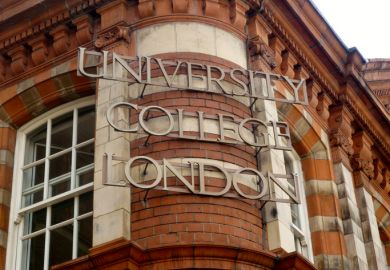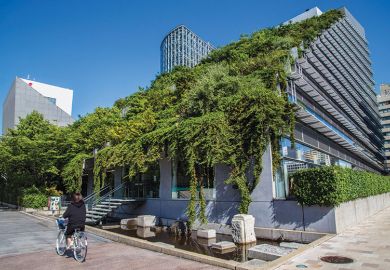Hilary Grainger is professor of architectural history and dean of academic development and quality assurance at the London College of Fashion, University of the Arts London. She is an authority on the architect Sir Ernest George and on the architecture of British crematoria. She is also president of the Association of the Study of Death in Society. She was appointed OBE for services to higher education in the Queen’s New Year Honours for 2018.
Where and when were you born?
Tynemouth, Tyne and Wear in 1952.
How has this shaped you?
My parents were schoolteachers who believed strongly in the value and importance of education. They were unfailingly encouraging and supportive, and I owe them a great deal. Being an only child, family and friends have always been important. Growing up on the north-east coast, I was instilled with a strong sense of place, belonging and love of the sea. It still exerts a strong draw. Coincidentally, some of my early higher education teaching was in Newcastle. Much of me has been defined by the north east. I feel entirely at home there.
Your latest book looks at the history of cremation in modern Scotland. What was the most interesting finding or anecdote you discovered during your research?
Uncovering Sir Basil Spence’s acrimonious relationship with Edinburgh’s city architect over the design of Mortonhall Crematorium. Spence threatened his resignation over the lack of funding and vision, arguing that “this job is giving me more trouble than Coventry Cathedral”. The episode exemplified a familiar story of compromises over cost, which led to much of the mediocrity of post-war crematoria design. Spence’s tenacity resulted in one of the finest buildings of its type in the UK. I take every opportunity to promote the importance of good design to the industry through my work with the Cremation Society.
What is the biggest misconception about your field of study?
People believe that any consideration of death, more specifically the disposal of the dead, is somehow distasteful, and yet, paradoxically, they are fascinated by the subject. Given that 76 per cent of people in the UK now choose cremation, surprisingly crematoria remain the “invisible buildings” of the 20th century. In an increasingly secular society, they have become the focus of ritual and the disposal and remembrance of the dead. They form a significant part of our cultural heritage, and their role in contemporary society needs to be better understood. We need to talk more openly about death.
What are the best and worst things about your job?
The best thing is working with some remarkable colleagues in a creative environment. The worst thing is anything going awry with the rail network. I commute from Birmingham to London and when things go wrong, they tend to go wrong in spectacular fashion.
What is your favourite building?
A challenging question for an architectural historian. I have always been interested in Victorian architecture and [I am] now chair of the Victorian Society. High on my list would be 39 Harrington Gardens, Kensington, built in 1882 for W. S. Gilbert by Sir Ernest George. This flamboyant and whimsical town house, so perfectly suited to its owner, holds a special significance for me. It prompted my interest in George, the subject of my PhD and subsequent monograph. George also designed Golders Green Crematorium in 1902 – hence my interest in cremation, at first sight an unusual preoccupation for a dean at the London College of Fashion.
If you were to design a university from scratch, what would it look like?
Architecture ought not to be judged by appearance alone. Buildings are for people, and a university is an academic and social project. The building would need to encompass functionalism, social purpose and, above all, collective endeavour. Flexibility would be paramount, and the trick might be to avoid the vagaries and excesses of style to ensure contemporary relevance.
What kind of undergraduate were you?
Diligent but, I hope, not earnest. I studied English and the history of art at the University of Leeds, a joint degree that involved a great deal of essay writing. As a PhD student, I later taught undergraduates in the fine art department. I subscribed to the notion of “work hard, play hard” and was president of my hall of residence, which led to a wholly memorable social life. I was keen on squash and played for the university team. Leeds is a great place to be a student.
If you were a prospective university student now facing £9,000-plus fees, would you go again or go straight into work?
I was very fortunate in having had my undergraduate fees paid by the local authority and received a university grant for my PhD at Leeds. It would be much more challenging now, but university is unquestionably transformative and I would not hesitate to return.
What advice do you give to your students?
I always advocate the importance of thinking critically, observing carefully and managing time effectively. Seize every opportunity – there is something to be learned from every situation, good or bad. Art and design students should locate their practice in context, be it cultural, historical, political or social, to better understand their own work and the role that it plays in society.
If you weren’t an academic, what do you think you’d be doing?
I am a practical person and have always loved drawing. I dare say I would have been an architect.
What do you do for fun?
Travel. I am constantly energised by new places. I enjoy reading a well-crafted novel and spending time with my daughters, one of whom lives and works in Edinburgh, the other in London. Both cities offer a huge range of interesting things to do and see.
Tell us about someone you’ve always admired.
Andrew Saint, who is unquestionably one of this country’s leading architectural historians. I have known Andrew for more than 40 years and have always admired his intellect, his acuity and the elegance and insightfulness of his writing. I always directed students to his books as models of masterly analysis and contextualisation of buildings. Furthermore, he is the most generous of academics and humane of men.
Register to continue
Why register?
- Registration is free and only takes a moment
- Once registered, you can read 3 articles a month
- Sign up for our newsletter
Subscribe
Or subscribe for unlimited access to:
- Unlimited access to news, views, insights & reviews
- Digital editions
- Digital access to THE’s university and college rankings analysis
Already registered or a current subscriber? Login








